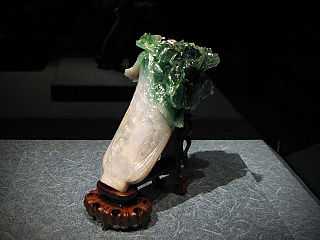Jadeite Cabbage
 | |
| Artist | Unknown |
|---|---|
| Year | 19th century |
| Type | Jadeite sculpture |
| Dimensions | 18.7 cm × 9.1 cm (7.4 in × 3.6 in) |
| Location | National Palace Museum, Taipei |
The Jadeite Cabbage (Chinese: 翠玉白菜; pinyin: Cuìyù Báicài; Pe̍h-ōe-jī: Chhùi-ge̍k Pe̍h-chhài) or Jadeite Cabbage with Insects is a piece of jadeite carved into the shape of a Chinese cabbage head, and with a locust and katydid camouflaged in the leaves. It is part of the collection of the National Palace Museum in Taipei, Taiwan.[1]
Description
The Jadeite Cabbage is a small sculpture. Measuring only 18.7 by 9.1 centimetres (7.4 by 3.6 in) and is 5.07 centimetres (2.00 in) thick,[1] it is "hardly larger than a human hand".[2]
The ruffled semi-translucent appearance of the leaves is due to the combination of various natural colors of the jade to recreate the color variations of a real cabbage.[1] The figure was carved from a single piece of half-white, half-green jadeite which contained numerous imperfections such as cracks and discolored blotches. These flaws were incorporated into the sculpture and became the veins in the cabbage's stalks and leaves.[3]
The sculpture has been considered an allegory of female virtue with the white stalk symbolizing purity, the leaves denoting fertility and abundance and locust and katydid representing children.[1][2]However, one of these two insect is a Chinese bush cricket (Gampsocleis gratiosa), not a katydid. It is a singing insect used during the Qing Dynasty to entertain guests at the palace banquet. Therefore, this Chinese bush cricket has nothing to do with the fertility and the abundance of children.
History
The sculptor of the Jadeite Cabbage is unknown. It was first displayed in the Forbidden City's Yonghe Palace, the residence of the Qing Empire's Guangxu Emperor's Consort Jin who probably received it as part of her dowry for her wedding to Guangxu, in 1889.[1][2] Following the fall of the Qing Empire in the Chinese Revolution of 1911, the sculpture became part of the collection of the Palace Museum in the Forbidden City. Along with a core of that collection, the piece survived the Second Sino-Japanese War (World War II) and the Chinese Civil War and was eventually relocated to Taiwan's National Palace Museum.
Notability
Despite its popularity with museum-goers and frequent misrepresentation as a national treasure, it in fact is only designated as a significant antiquity, having less rarity and value than required for categorization as a national treasure under the Cultural Heritage Preservation Act.[4] For example, the Jadeite Cabbage has been called the "most famous masterpiece" of the entire National Palace Museum,[2] and along with the Meat-shaped Stone and the Mao Gong Ding, is today called one of the Three Treasures of the National Palace Museum, a redesignation from several less accessible, infrequently-displayed works.[5] It has also been chosen by the public as the most important item in the museum's entire collection.[3]
References
- ↑ 1.0 1.1 1.2 1.3 1.4 Jadeite Cabbage with Insects at the National Palace Museum website. Retrieved 20 November 2010.
- ↑ 2.0 2.1 2.2 2.3 Leslie Hook. "The Jade Cabbage" Wall Street Journal. 27 July 2007. Retrieved 20 November 2010.
- ↑ 3.0 3.1 Sam Ju. "The Crystallization of the Jadeite Cabbage." Translated by David Smith. Taiwan Panorama. October 2009. p. 83. Retrieved 20 November 2010.
- ↑ 江昭倫,故宮副院長馮明珠:不反對翠玉白菜、肉形石升級為國寶,中央廣播電台,2009-03-26
- ↑ 倪再沁 (2007). "神畫的形塑—論故宮三寶".
External links
- Jadeite Cabbage with Insects at the National Palace Museum website
- Leslie Hook. "The Jade Cabbage" Wall Street Journal. 27 July 2007.